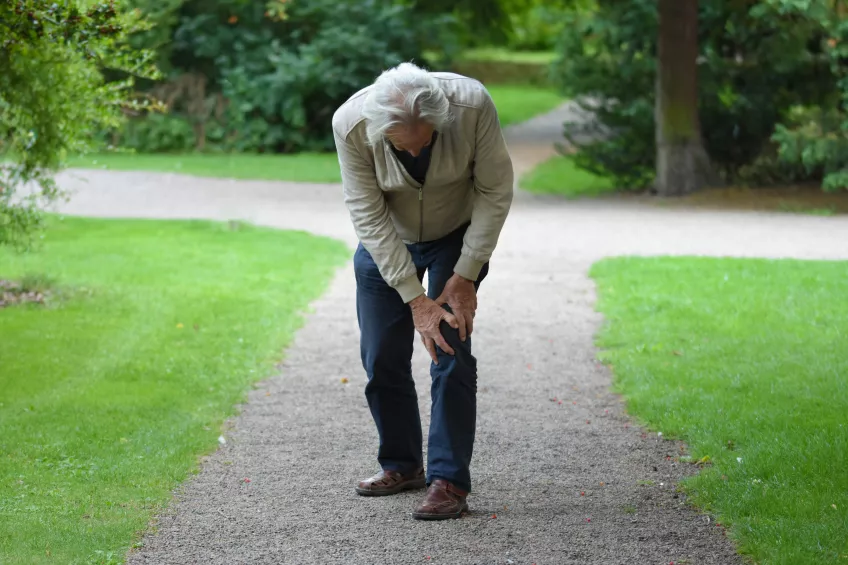Symptoms of OA
Stiffness, pain, and swelling of the joints can be signs of osteoarthritis (OA). However, depending on which joint is affected, these symptoms may vary. Listed below are the most common symptoms of OA in different joints.
Experiencing stiffness or pain in one or more joints, especially after applying pressure to the joint, may be symptoms of OA. The more risk factors you have (OA in the family, being overweight, old age) the higher the probability is of these symptoms being signs of OA. This especially goes for those who are at risk of developing the disease.
However, it is not uncommon that people affected by OA go about life with symptoms for a long period of time before seeking medical care. This is a reason why there is such a large number of unrecorded cases of people affected by OA. Seeking medical care and getting the right diagnosis on time to be able to commence first-line treatment, increases the chances of living an active life with less pain and increased joint mobility.
Below you can read about the signs and symptoms that characterize OA in different joints. Keep in mind that suffering from these symptoms does not automatically mean that you have OA Other rheumatic diseases, injuries or joint overuse can produce similar symptoms. Therefore, it is important to get the right diagnosis from a physiotherapist or a doctor.
Knee osteoarthritis
Symptoms include knee stiffness in the morning and pain that occurs when you apply pressure to the knee joint. The knee may also swell. The pain is often located at the back or the front of the knee. It may become increasingly difficult to climb stairs, stand up from a seated position or perform knee bend movements, such as squats. The knee may occasionally also pop or lock itself.
Hip osteoarthritis
Symptoms include hip stiffness and pain. The pain is typically located in the groin or buttock but can radiate all the way down to the knee. The pain mainly arises during or after physical activity, although it is also common to experience pain when at rest. It may become difficult to perform movements that require the hip joint to bend or rotate, such as tying your shoes, sitting with your legs crossed, or getting in and out of a car.
Hand osteoarthritis
OA of the hand usually affects the joints closest to the fingertips and the base of the thumb, but it can also affect the middle joint of the fingers and the wrist. Common symptoms of OA of the fingers include finger stiffness and hard lumps filled with synovial fluid appearing on the affected finger joints. OA of the thumb is characterized by stiffness and pain of the thumb. OA of the wrist can cause wrist stiffness and pain. Regardless of which part of the hand has been affected by OA, it normally becomes difficult to grasp things properly due to pain and hand weakness.
Osteoarthritis of the foot
As the foot has 33 joints, the foot can be affected by OA in several different places. However, it is most common for the big toe to be affected by the joint disease. OA of the big toe is in medical terms known as “hallux rigidus”. The big toe can feel stiff, hurt and can become difficult to find shoes that feel comfortable. Some also suffer from OA of the ankle but this is less common than OA of the big toe. General symptoms of OA of the foot include swelling and pain when walking or running.
Osteoarthritis of the jaw
When the temporomandibular joint (TMJ) which connects the jawbone to the skull, is affected by OA, the jaw often feels stiff, and it may hurt when moving your jaw. The jaw may also produce clicking or grinding noises. In severe cases, it can become very difficult to open and close your mouth which can result in chewing problems.
Shoulder osteoarthritis
When OA affects the shoulder, it can become difficult to lift things or perform everyday tasks that require movement of the shoulder, such as putting on a sweater or combing your hair. The shoulder often feels stiff, and pain can be present both during movement and at rest. Constant dull pain in the shoulder is common.
Spinal osteoarthritis
OA of the spine, also known as spondylosis, is very often difficult to diagnose as back pain is fairly common and can have several underlying causes. OA of the spine often affects the neck or the lower back and causes pain and stiffness in these areas.
AC joint osteoarthritis
The acromioclavicular (AC) joint is a small joint located between the collarbone and the shoulder blade. Symptoms are very similar to the symptoms experienced when affected by shoulder OA. Shoulder pain is most common, especially when lifting the arm, but the collarbone may also feel sore. Usually, the pain is worse after using the joint, however, pain at rest is not uncommon.


